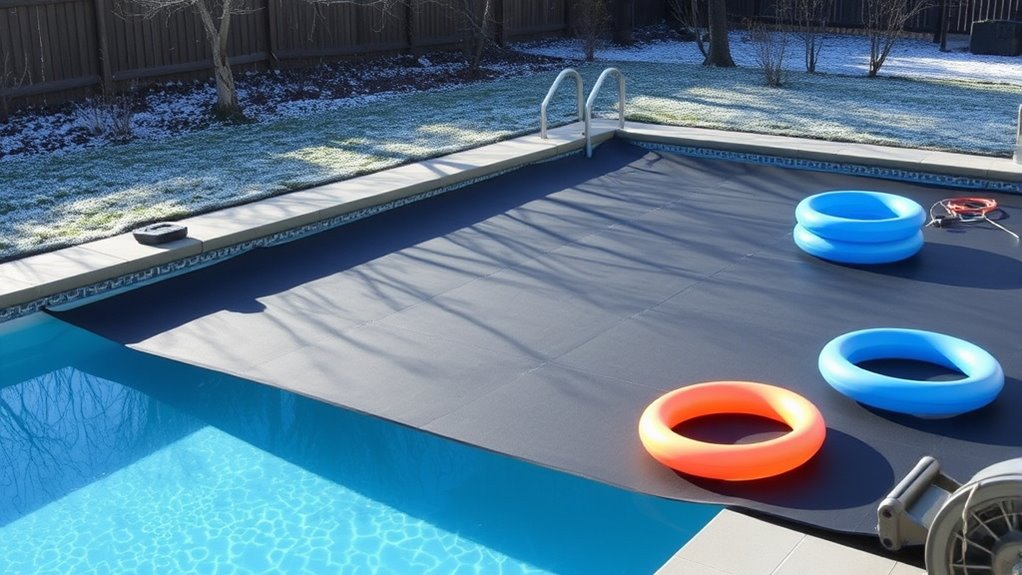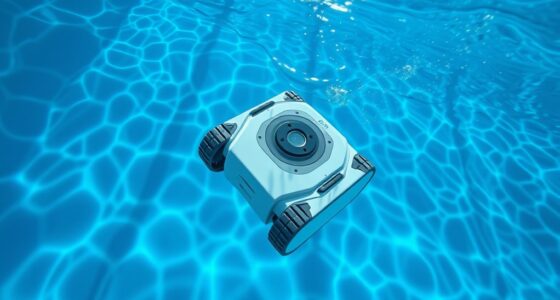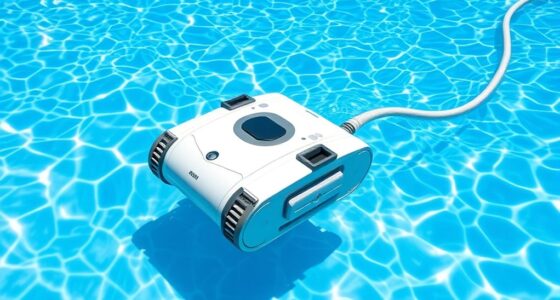To get your pool ready for winter, start by thoroughly cleaning the water and balancing the chemicals to prevent stains and algae. Drain all equipment, blow out lines, and add antifreeze where needed. Lower the water level, then install your chosen cover, making sure it’s securely anchored and free of wrinkles. Store accessories safely and turn off power to avoid damage. If you want to learn more about each step, there’s plenty of helpful tips ahead.
Key Takeaways
- Balance and shock the pool water, then add stain preventers and enzymes to protect against algae and scale.
- Drain and blow out plumbing lines, remove drain plugs, and add antifreeze to prevent freezing damage.
- Lower water level below the skimmer, and install a suitable cover securely with straps and weights.
- Remove and clean all equipment, store indoors, and prepare pumps and filters for spring restart.
- Ensure outdoor outlets are weatherproofed, and turn off and secure all electrical components for winter.
Cleaning and Balancing Your Pool Water
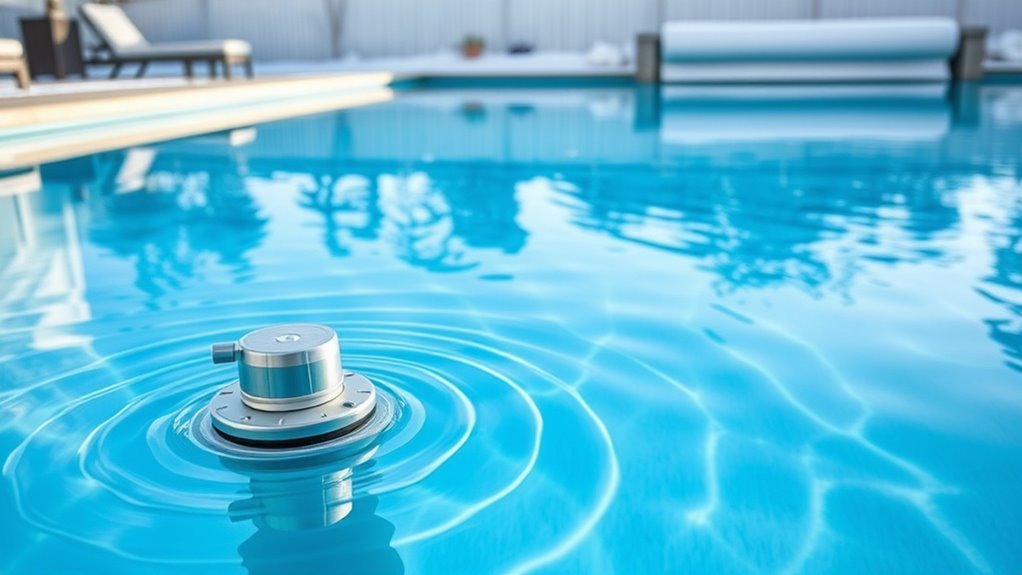
Before winter arrives, it’s essential to clean and balance your pool water to prevent damage and guarantee it’s ready for the off-season. Start by removing debris with a skimmer to clear leaves and floating dirt. Vacuum the pool floor and walls thoroughly to eliminate sediment and prevent algae buildup. Brush the walls to prevent pool algae and stains. Perform chemical testing to check pH, alkalinity, calcium hardness, and stabilizer levels. Adjust chemicals as needed to keep water balanced, which helps protect your pool surfaces and equipment during winter. Properly balanced water reduces the risk of staining and corrosion. Regular testing ensures your pool chemistry stays in check throughout the winter, avoiding costly repairs or algae growth when you reopen next season. Additionally, balanced water chemistry can help prevent freezing issues and damage caused by improper chemical levels during the off-season. Maintaining optimal chemical levels also supports air filtration and overall pool health during the colder months.
Applying Proper Winterizing Chemicals
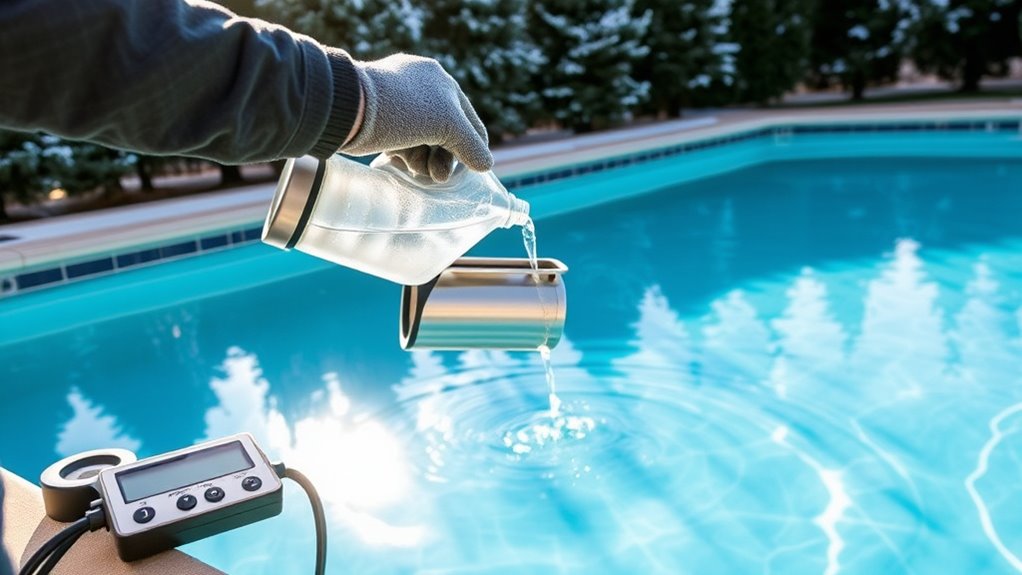
Applying proper winterizing chemicals is essential to protect your pool during the off-season. First, make chemical adjustments to balance pH levels between 7.2 and 7.4, preventing damage to your pool and equipment. Next, guarantee chlorine levels are below 4 ppm before applying algaecide, which helps prevent algae growth during winter. Choose the right algaecide type—either polymer, quat, or copper-based—based on your pool’s needs, but avoid overuse of copper to prevent staining. Incorporate a shock treatment to eliminate residual contaminants and organic matter. Additionally, add stain and scale preventers to safeguard surfaces, and enzymes to break down organic residues. Proper chemical adjustments and targeted algaecide application are key steps to ensure your pool remains in good condition throughout the off-season. Test water parameters regularly to ensure all chemical levels remain within safe and effective ranges during winterization, and consider using self watering plant pots to keep your garden healthy during the colder months when outdoor watering is less frequent.
Protecting and Draining Pool Equipment

Protecting and draining your pool equipment properly helps prevent costly damage during winter months. Start by removing drain plugs from the pump, filter, and heater to ensure complete drainage before freezing temperatures arrive. Use compressed air to blow out remaining water from pipes and equipment, reducing the risk of cracks or bursts. Then, plug openings at the pool wall to stop water from re-entering the plumbing system. For outdoor furniture protection, cover equipment with insulated, waterproof covers designed for winter use, and perform regular inspections to keep covers dry and secure. Additionally, understanding angel numbers related to love and spiritual connection can inspire a sense of hope and renewal during the off-season. Properly winterizing your equipment can extend its lifespan and save money on repairs. Imagine:
Drain and cover pool equipment to prevent winter damage and keep it dry and secure.
- Drained pipes preventing cracks from expanding ice.
- Covered equipment staying dry and rust-free.
- Proper pool cover maintenance reducing strain and damage.
Adjusting Water Levels for Winter
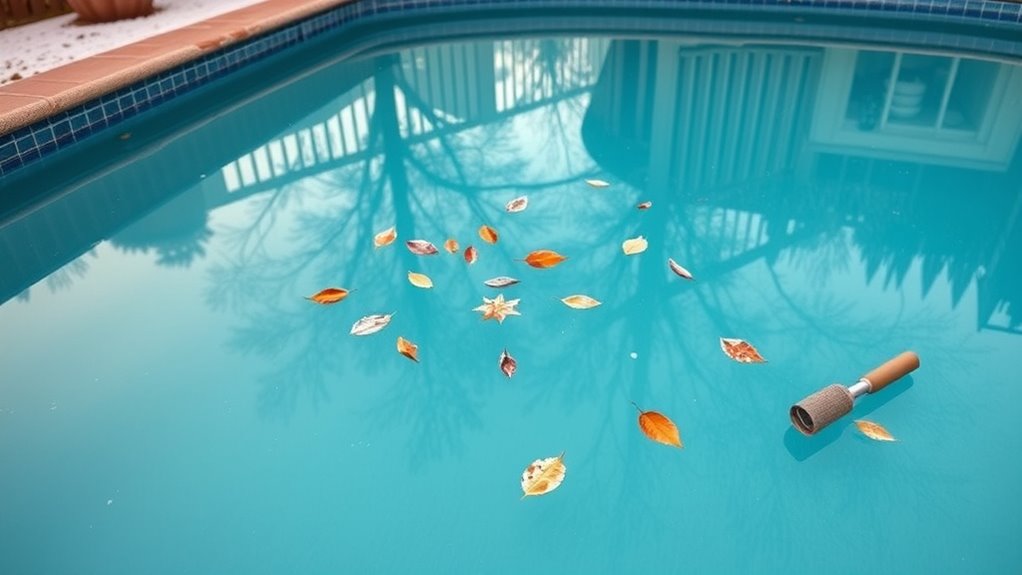
To protect your pool from winter damage, you need to adjust the water level properly. Typically, you should lower it to about 1 inch below the skimmer, but this can vary based on your pool setup. Using a submersible pump can make this process easier and more accurate. Proper water level helps prevent ice damage and ensures the pool’s structural integrity during freezing temperatures. Additionally, maintaining the correct water level aligns with best practices for remote work productivity during seasonal changes.
Water Level Guidelines
Wondering how to set the right water level for winterizing your pool? Proper water level is vital for maintaining pool chemistry and ensuring your winter cover works effectively. Here’s what you should visualize:
- Imagine the water sitting just below the skimmer opening if you use a solid cover, about 4-6 inches lower. Maintaining this level helps prevent water from pooling on the cover and causing damage.
- Picture lowering the water 12-18 inches below the skimmer if you have a mesh cover, allowing drainage. This prevents debris accumulation and reduces stress on the cover.
- Envision maintaining a level 6-12 inches below the tiles for safety covers, preventing stress on the cover. Proper water levels also assist in avoiding ice damage during freezing temperatures.
- Regularly check and adjust the water to prevent damage from freezing, as water levels that are too high or low can cause cover stress or damage to the pool’s structure. Water level monitoring is crucial during winter to avoid costly repairs come spring.
Using Submersible Pumps
Using a submersible pump makes adjusting your pool’s water level quick and efficient during winterizing. When choosing a pump, focus on pump selection by prioritizing energy efficiency, automatic features, high flow rate, and freeze protection to handle cold conditions. Ensure the pump is fully submersible and has a long power cord for easier positioning. Proper pump maintenance is essential—regularly check for debris, monitor operation, and clean filters to prevent clogging. Secure the pump with a rope if needed to keep it in place. During winter, routinely inspect the water level and debris buildup to maintain ideal performance. Well-maintained pumps reduce risks of freezing damage and failure, making water level adjustments smoother and safer throughout the off-season.
Installing Pool Covers for the Off-Season

Installing your pool cover correctly is essential to guarantee it stays secure and effective throughout the off-season. Start by choosing the right cover type: solid covers block debris and sunlight, while mesh safety covers allow water drainage. Once you’ve selected, lay the cover carefully over the pool, ensuring it sits evenly. Visualize:
- Spreading the cover smoothly, avoiding wrinkles and ensuring equal overlap.
- Anchoring straps or springs around the perimeter, spaced about 18 inches from the edge, and tightening them evenly.
- Placing water bags or tubes at the edges to hold the cover down securely. Proper installation also involves checking the material durability, ensuring that the cover can withstand winter weather conditions without tearing or deteriorating over time.
Secure cover straps tightly to prevent shifting, and pad sharp edges to avoid tears. Proper installation guarantees your pool stays protected all winter long. Additionally, correct installation reduces the risk of damage caused by wind or heavy snow buildup, ensuring durability throughout the cold months.
Safeguarding Skimmers and Drains

Safeguarding your skimmers and drains is a crucial step in winterizing your pool, especially when preparing for the off-season. Proper skimmer maintenance and drain line protection prevent freeze damage and costly repairs. Use an air compressor or cyclone blower to blow out lines, then plug them securely. Applying antifreeze adds an extra layer of protection against freezing. Here’s a quick guide:
| Step | Tool/Method | Purpose |
|---|---|---|
| Blow out skimmer lines | Air compressor or cyclone blower | Remove water to prevent freezing |
| Plug lines | Expansion plugs | Seal lines after blowing out |
| Add antifreeze | Pool-compatible antifreeze | Protects against freeze damage |
| Monitor water levels | Seasonal cover guidelines | Ensure cover support and safety |
Following these steps ensures your skimmers and drains stay intact through winter’s chill. Proper preparation also involves understanding freeze damage risks and how to prevent them effectively.
Shutting Down and Storing Pool Accessories

Before you close up your pool for the winter, it’s important to remove and properly store all accessories like ladders, hoses, and cleaners. Proper pool accessory organization helps prevent damage and makes spring setup easier. Start by cleaning each item thoroughly and inspecting for wear or damage. Use clear storage bins or labels to keep smaller items organized. Consider storing equipment in a fully enclosed structure like a pool shed to protect against moisture and cold. Additionally, using durable materials such as modern fixtures can extend the lifespan of your accessories and ensure they remain in good condition. Here are some equipment storage tips:
- Store ladders and steps indoors to prevent rust.
- Keep hoses dry and coiled neatly.
- Drain and dry pool cleaners before storing.
Organized storage guarantees your accessories stay in good condition and ready for next season.
Securing Your Pool’s Power and Controls

To safeguard your pool’s power and controls during winter, you need to shut off the electrical supply and make sure all components are properly secured. Start by turning off the circuit breaker dedicated to the pool pump and equipment. Use lockout/tagout procedures or physical tags to prevent accidental re-energizing during winterization, ensuring electrical safety. Inspect outdoor outlets, verifying they have weatherproof covers and GFCI protection to prevent moisture intrusion. Unplug control devices and automation controllers to protect against power surges and moisture damage. Remove batteries and backup modules from smart controls, then cover panels with waterproof, breathable covers. Double-check that manual overrides and safety interlocks are engaged, and avoid sealing control boxes to prevent humidity buildup, which can cause corrosion. Additionally, consider essential oils for electrical safety, which can help prevent corrosion and maintain optimal functioning of your equipment during the off-season.
Preparing for a Seamless Spring Restart
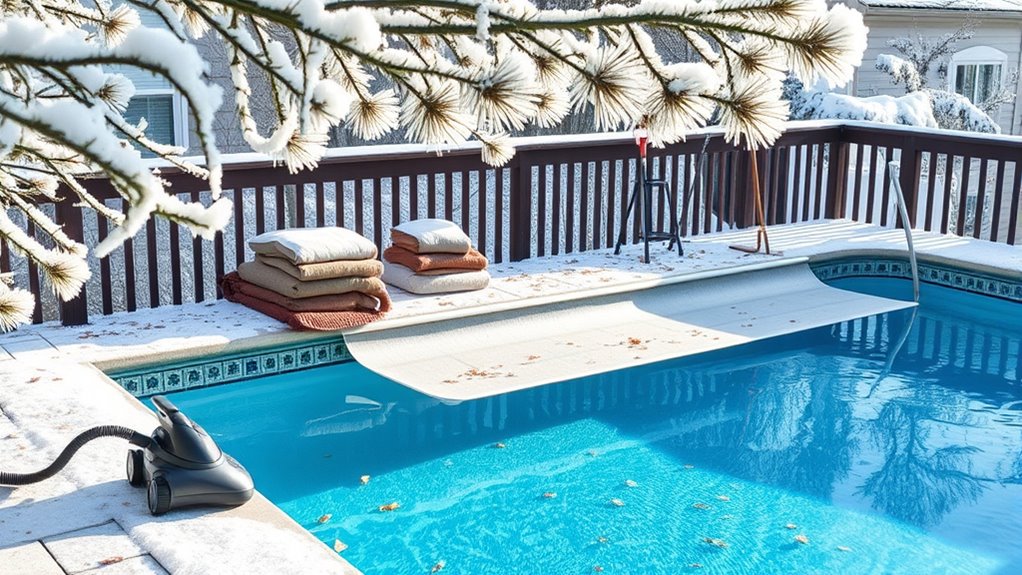
As winter ends, it’s important to inspect and clean your pool equipment to make sure everything functions smoothly. Be sure to store supplies properly to prevent damage and make spring setup easier. Taking these steps now helps you enjoy a hassle-free pool reopening. Additionally, verifying the integrity of your pool’s trust foundation can prevent surprises during the off-season transition.
Inspect and Clean Equipment
Inspecting and cleaning your pool equipment is essential to guarantee everything functions properly when the season resumes. Start by examining your pumps and filters for damage or blockages, ensuring all parts are securely fastened to maintain proper water circulation. Next, check the heater and plumbing lines for leaks or obstructions that can affect water flow and heating efficiency. Finally, verify your pool lights are working correctly and undamaged, preventing surprises when you reopen the pool. To keep equipment in top shape, consider: 1. Backwashing filters to remove debris and contaminants. 2. Cleaning pumps and heaters to prevent buildup. 3. Draining and cleaning pool lines to avoid clogs. These steps help ensure your pool’s water circulation remains smooth and your pool chemical balance stays stable for a seamless restart. Additionally, reviewing Pool Support Hours can help you plan maintenance during off-peak times to avoid service delays.
Store Supplies Properly
Properly storing your pool supplies guarantees they stay safe and functional until spring. Focus on chemical storage by keeping all chemicals in their original containers or airtight bins to prevent moisture and fumes from escaping. Store chemicals in a well-ventilated, climate-controlled area away from flammable materials, and separate incompatible chemicals to avoid hazardous reactions. For pool liners, especially soft-sided above-ground types, ensure they are thoroughly dry and carefully folded toward the center to minimize tears. Use plastic totes to organize small parts and accessories, which helps protect them from moisture and damage. Keep everything in a dry, stable environment like a garage or basement, avoiding exposure to extreme temperatures or moisture. Additionally, considering the horsepower of electric dirt bikes, using proper storage methods can help maintain the integrity of any electrical components or batteries. Proper storage guarantees your supplies remain in good condition, ready for a seamless spring restart.
Frequently Asked Questions
When Is the Best Time to Start Winterizing My Pool?
You should start winterizing your pool when air and water temperatures stay at 65°F (18°C) or below, ensuring water chemistry is balanced and safety precautions are in place. Avoid rushing too early, as this can promote algae growth, or waiting too long, risking freeze damage. Proper timing helps protect your pool’s structure and equipment, making the off-season maintenance smoother and preventing costly repairs come spring.
How Do I Prevent Algae Growth During Winter?
To prevent algae growth during winter, you need to keep your pool’s chemical balance stable. Maintain proper pH, alkalinity, and CYA levels, and keep chlorine levels between 2-4 ppm. Regular filtration maintenance is essential—run your filter 16-18 hours daily, clean it often, and guarantee circulation is effective. Use algaecides and shock treatments as needed, brushing and vacuuming the pool to remove debris and nutrients that promote algae growth.
What Are the Signs of Freeze Damage in Pool Equipment?
Did you know that over 60% of pool repairs in winter are due to freeze damage? Signs include leaks, cracks, or strange noises from your equipment. You should inspect your pool cover regularly and manage water levels carefully to prevent ice formation. Look for visible cracks in pumps, heaters, or pipes, and check for leaks or bulging areas. Promptly addressing these signs helps avoid costly repairs.
Can I Winterize My Pool Without Draining the Water?
You can winterize your pool without draining the water, but you need to focus on maintaining proper chemical balance and inspecting your equipment first. Keep the water levels stable, treat the water with winterizing chemicals, and verify all equipment like filters and pumps are in good condition. This approach helps protect your pool and equipment from damage during the off-season, saving time and resources for spring reopening.
How Do I Know if My Pool Cover Is Properly Secured?
Think of your pool cover like a tightrope walker’s safety net. To guarantee it’s secure, check the cover tension—no sagging or slack—and make sure all straps are secure, straight, and evenly tensioned. Look for uniform overlap and smooth, taut material. If straps pull unevenly or springs are fully compressed, it’s a sign your cover isn’t properly secured. Adjust straps and tension until everything feels firm and balanced.
Conclusion
By winterizing your pool properly, you’re not just protecting your investment — you’re safeguarding a majestic aquatic kingdom from the icy grip of winter’s relentless reign. With these steps, you’ll transform your off-season preparations into an artful fortress, ensuring your pool remains pristine and ready to dazzle come spring. Skip this, and you risk turning your shimmering oasis into a frozen, forgotten relic of seasons past. Stay diligent, and your pool will thank you with endless summer splendor.
